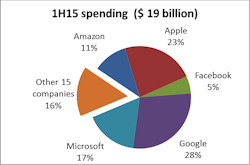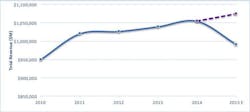Spending by the top 15 Web 2.0 companies on servers, network equipment, and other property and equipment rose 16% in the first half of 2015, according to LightCounting. Coincidentally, capex spending from the top 15 traditional service providers declined by the same amount, according to the market research firm, based on its "August 2015 Market Forecast Report and Database."
The 15 Web 2.0 companies in LightCounting's "Internet Index" expended $19 billion in capex during the first six months of the year, the market researchers say (see chart above). The five biggest spenders -- Amazon, Apple, Facebook, Google, and Microsoft -- accounted for $16.2 billion, 84% of the total sum. Google led the way with $5.4 billion in capex, with Apple next at $4.4 billion.
Meanwhile, Chinese Web 2.0 companies stepped up their capex outlays year-on-year by 56%. Tencent spent 101% more than in 1H14 ($672 million), while Alibaba spent 86% more ($527 million).
On the other hand, the weak capex outlays among the top 15 service providers in the first half likely dooms that segment to an overall decline of at least 6% for the year, to around $184 billion, LightCounting believes. The strength of the dollar relative to other currencies is a major factor, the market research firm says. For example, while Chinese capex generally is stronger in the second of the year than in the first six months, the devaluation of the yuan will limit total capex figures.
That said, there are some bright spots, if you keep things in the local currency. Europe, for example, saw network investment increases in euros, while Japanese operators continue to report revenue growth in yen.
But these bright spots won't be bright enough to light the gathering revenue darkness, LightCounting believes. The analysts forecast that the revenues among the 15 leading operators will join capex and decline in 2015. An expected revenues slippage of 6% (to $992 billion) would be the first such decline since 2009. The graph below illustrates revenue trends for the past five years, with the purple dashed line illustrating how revenues would actually have grown this year had foreign exchange rates remained stable since 1H14.
With such trends as a background, the fourth quarter will have to be very good if the optical networking market is to see overall growth for the year. LightCounting notes that some large 100G projects have been delayed to the very end of the year. Further delays would imperil LightCounting's current projections for 25% growth in sales of optical components and modules in 2015. The ability of suppliers to keep pace with strong demand for FTTx optics and new products such as DWDM CFP transponders also are concerns.
For more information on optical components and suppliers, visit the Lightwave Buyer's Guide.

